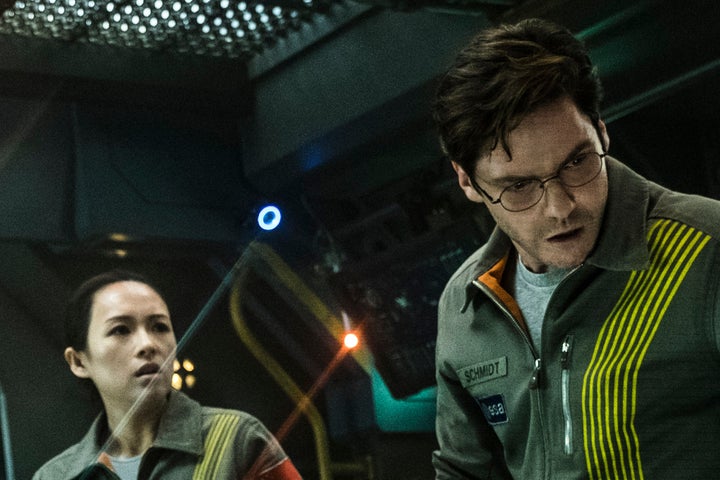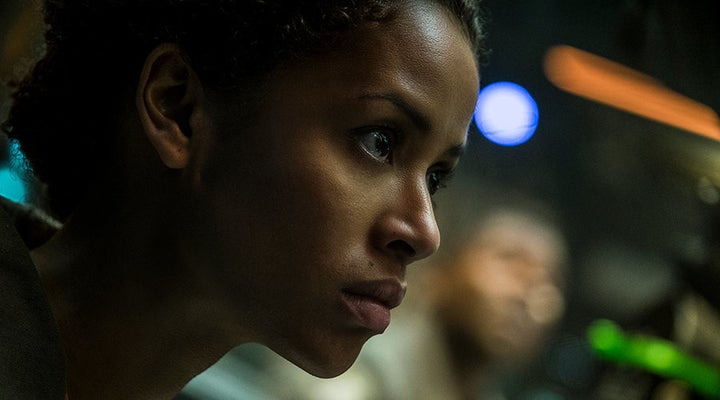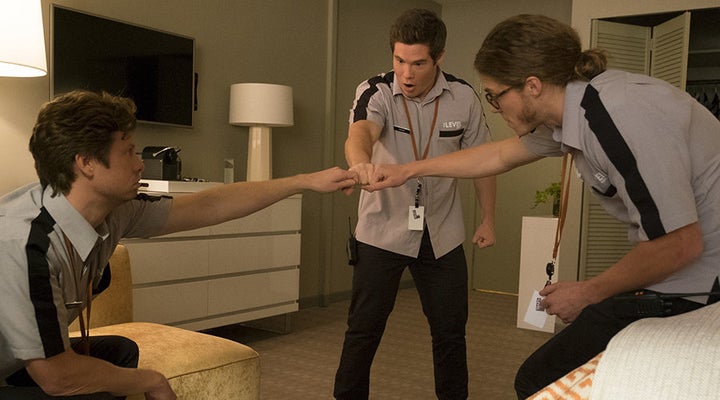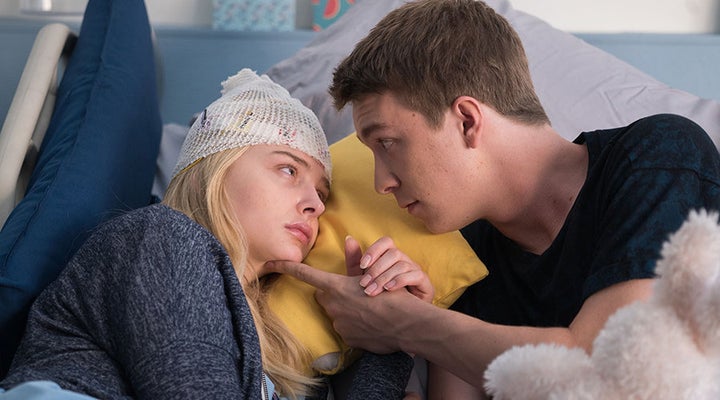Much of my job working on HuffPost’s Streamline focuses on recommending how you should spend your precious time streaming on Netflix. It’s become increasingly hard to keep up with the best the service has to offer, as they add so many Originals each week. I certainly have had no time for what seemed to be Netflix’s worst.
Until now.
For your amusement, I decided to go on a journey to break my brain and watch the five worst-reviewed Netflix Original movies of 2018. I did this by watching them all in a row over the course of half a day. At numerous points, I wanted to give up on this trek into Netflix’s darkest core, but I persevered and lived to tell this tale. And it is a tale.
First, a note on my methodology: I determined which movies earned the worst reviews by comparing Rotten Tomatoes and Metacritic scores along with reviews from critics I especially trust. I settled on five movies to retain my sanity, but easily could have expanded this list to include more, such as “Mute,” “The Outsider,” “Tao,” “The Week Of,” “Extinction,” “The Titan,” and “When We First Met.” Maybe I’ll watch them for the end-of-year version of this list, but for now, I just focused on the spectacularly bad. The worst of the worst.
To determine this, I focused on movies that had inexplicably terrible elements. Arguably, the truly “worst” movies out there are just incredibly boring, have terrible actors, and only secured low budgets. That’s not this list.
All the movies below are actually competent in many ways. Some even have truly great moments or elements, but this juxtaposition makes the terrible parts all the more fun and cringe-worthy. All these movies have incredibly rotten components that ruin all the good parts, and that makes them the absolute worst.
There are extensive spoilers here. I don’t want you to waste your time with these movies and, in many cases, the ending is the worst part. So read the list below instead of actually spending any time with these lowlights of 2018. And wish me luck on my recovery.
And if you want to stay informed about what’s joining Netflix on a weekly basis, be sure to subscribe to the Streamline newsletter.


Streamline makes recommendations for streaming shows and movies. Every Saturday, Streamline highlights the best shows to watch online, with a focus on Netflix.
“How It Ends”

Premise: Something cataclysmic happens to the West Coast of the United States. A man (Theo James) joins his potential father-in-law (Forest Whitaker) to try to save his fiancée. The two must travel from Chicago to Seattle by car and foot.
After the attack, power and cell reception goes out across the United States, reaching from the West to at least the Midwest. In less than 24 hours, America devolves into violent chaos.
The opening scene: The first shot focuses on an ultrasound. A woman learns she will have a boy, while her fiancé sits next to her.
The movie claims to be set in Seattle, but never shows establishing shots of the city, despite having a ridiculous amount of establishing shots for Chicago in the scene right after this.
As the couple steps outside after the ultrasound, the woman tells the man he should be brave when talking to her father (in Chicago) about wanting to marry her. She asks, “Is everything going to be OK?” referring to talking to her dad, but also ― foreshadowing.
Top three reasons it’s bad:
1. Almost every single scene involves preposterous conflict. While the two protagonists ― the fiancé and the father― travel on the road, trekking across America, this kind of makes sense. Beautiful cinematography and colorization allow the long drive to take on a poetic quality that helps the suspension of disbelief. But after every single person they encounter wants to kill them ― just hours into this mysterious attack ― that suspension of disbelief has to do too much work.
The first 20 minutes and the last 20 minutes of this movie have that same ridiculous conflict, but with no redeeming qualities. When the fiancé meets with the parents, he starts swearing and yelling at them during dinner for almost no reason.
The movie ends with the fiancé finding that his future wife shacked up with a neighbor in a remote forest for safety. Then this neighbor randomly becomes evil and tries to kill the fiancé, leading to the fiancé shooting him. A storm descends on the area seconds later. The fiancé rushes back to his partner and tells her to get in a car so they can outrun this new storm. He basically mutters that he killed the other person under his breath and she just rolls with it without asking questions.
2. This might be the worst ending I have ever seen. This makes the movie title hilarious in retrospect, because “how it ends” is the most notable thing about this movie. Almost every review I have seen ― including casual comments on the trailer ― point out that the ending is unbelievably bad.
The movie starts coming to a close with the fiancé making it to Seattle. He finds the city completely decimated and abandoned. Toxic ash floats in the air and covers everything. He finds a face mask in a firetruck and walks through the rubble until he finds his old apartment. The walls are missing and everything is destroyed, but somehow a door survived that has a message from his partner about her whereabouts. She wrote it in marker. He then heads back to his car and simply drives to this address outside the city.
He finds her there with a neighbor who acts creepy despite just being a random neighbor. They explain they had only minutes to escape the city after the initial warning. Somehow they both got to a car and escaped from the middle of the city through congested roads in those few minutes. At the safehouse, the fiancé doesn’t immediately shower to clean the toxic ash off his body. In fact, he climbs in bed with his partner and they snuggle. You can still see the dirt and ash all over his body.
Then after telling his partner he’ll never leave her again, he gets up from bed. Apparently a time jump has happened and it’s now the middle of the night. He finds his partner at a fire with the neighbor. The neighbor says that he thinks the U.S. government might be behind the destruction, and our protagonist gets irrationally angry about this. After a weirdly tense moment that lasts about a minute, they all go to bed. The next morning, the aforementioned random confrontation and killing happens. Immediately after this, the two original partners drive into the distance, escaping another toxic cloud with just seconds to spare. Then this thing ends with no explanation for anything.
3. The fiancé becomes a master driver and gunslinger by the end of his journey, despite not knowing how to even load a gun at the start of this. He can also miraculously drive like a professional stuntman.
If you somehow ignore all realism, stretches of this movie actually do succeed in being entertaining. It’s kind of fun to just watch a movie that only knows how to portray forward movement (with the speeding car) or violent action. But you’ll reach your limit at some point.
Memorable unintentional comedy: When the father and fiancé leave for their journey, they must say goodbye to the father’s wife. Because this movie refuses to linger in any moment, the characters basically rush their goodbyes despite possibly never seeing this person again. The father gives a quick hug to his wife and then immediately turns around to head into the car. He almost never mentions her again.
Runtime: 1 hour, 53 minutes.
Trailer:
“Father of the Year”

Premise: Two recent college graduates return home. At a bar, they wonder which of their fathers would win in a fight. Then this argument serves as the basis for the entire movie, despite neither character seeming to actually care about the answer. The fathers, who don’t normally get in fights, take this argument extremely seriously for some reason.
One father (David Spade) seems incredibly dumb and always gets into trouble. The other father (Nat Faxon) seems incredibly wimpish and always gets run over by others. This doesn’t change by the end of the movie.
The opening scene: The two graduates sit in their car, discussing how they should have just went straight to New York City instead of returning home. The son of David Spade’s character watches as his father climbs from underneath his small house to drag a disgusting mattress out, presumably for his son to sleep on. The duo exits the car to greet him. Then the father goes on a tangent about how he really needs a Q-tip and doesn’t have one. He shows the kids his “pool” ― a back of his neighbor’s pickup truck that he’s filled with water. Spade’s character takes a skinny dip. Then the owner of the vehicle starts the car and drives away, causing Spade’s naked character to fall into the road.
Top three reasons it’s bad:
1. The plot makes no sense. This hypothetical fight between two fathers does not become interesting at any point in the movie and yet has to propel this whole thing.
The few side narratives also make no sense. One of the graduates, a valedictorian from a supposed Ivy League college, establishes that he worked his whole life to escape his hometown.
By the end of the movie, he decides to throw that all away to stay in this town after hanging around for just a couple months. He gives up his job because the head of the company lightly insults his dad. He decides a girl he dates for, like, a month is the love of his life.
2. David Spade’s character has a recurring joke about how he can’t help telling racist jokes to people of the race he’s making fun of because he’s colorblind — get it? Part of the joke is that it’d be all right if he was telling the jokes to white people, but what makes him an idiot is accidentally telling them to people of color. Not much to say about this except how is this a thing in 2018?
3. Like “How It Ends,” the title contributes to the nonsense. Netflix originally called this movie “Graduates,” and the marketing images for the movie still use the word “graduates” in the file names. “Father of the Year” clearly got tacked on at the last minute. At no point in this movie does either father get referenced as the father of the year, nor do they succeed enough to warrant such a distinction. Neither father pulls through and helps their child in any meaningful way. Both fathers start and end as buffoons. The nonsensical nature of this title may always haunt me.
Memorable unintentional comedy: Throughout the movie, older women keep getting turned on by one of the recent college grads because he is apparently so muscular that the women can’t help themselves. The actor barely looks any more buff than most Hollywood actors, though. He’s nowhere near the supersized physiques of actors like Dwayne Johnson or Taylor Lautner, an actor roughly the character’s age. So much of this movie focuses on how strong this character has become since childhood, so it’s weird they didn’t find a truly jacked actor.
Runtime: 1 hour, 34 minutes.
Trailer:
“The Cloverfield Paradox”

Premise: The Earth has run out of power. In a last-ditch effort, astronauts from different countries go to space to try and harvest energy. The way they do this fails, but ultimately disrupts the universe and sends the crew to an alternate reality.
The crew must try to return home, despite freaky things happening to their ship. In this alternate reality, their crew crashed back into Earth and World War III began. The crew realizes they don’t have to just go home — they also must find a way to actually harvest energy or else their world will kill itself.
The opening scene: Radio announcements set the scene of a world hurtling toward dystopia. Then the camera focuses on two lovers sitting in a car. They’re waiting in a long line to get gas. A blackout occurs. The two discuss their love and the sacrifices they’d make for each other. One lover will accept a mission to travel to space and try to harvest energy. Compared to these other “worst Netflix movies,” this opening stood out as the best. Nothing too awful here.
Top three reasons it’s bad:
1. Like “How It Ends,” the awfulness of the ending overshadows the whole film, which forces a twist that’s laugh-out-loud horrible into its final dozen seconds.
The movie ends with two survivors in the astronaut crew successfully returning to their reality/universe and finally harvesting the energy they need correctly. A crew on Earth cheers and the duo immediately boards a pod to return home. Then the aforementioned lover who’s still on earth gets a call from someone informing him that his partner returned safely and figured out the energy problem. The informant casually mentions that she’ll return within hours.
Then the lover starts screaming into the phone, asking why his partner wasn’t told about the situation on Earth. The dialogue here is careful not to betray anything about this new situation. The informant retains his casual tone and says it’s fine, there just wasn’t enough time and they’ll sort it out when she lands. The informant says the lover should go and meet his partner at the landing zone. At this, the lover starts screaming that the astronauts should be told to go back.
The movie then cuts to the astronauts re-entering the Earth’s atmosphere. They reach some clouds, which a poorly CGI’ed monster jumps through, roaring for seemingly no reason. At first, I thought the monster swallowed the pod, but upon rewatching, I realized the pod disappears into the clouds just a bit behind the monster.
Before this point, the movie never establishes that monsters have invaded Earth, except for a small hint which I’ll get into in the section below. The fact that the informant retains such a casual tone as an incredibly huge monster (so big that it can hover over the clouds) terrorizes the landing route seems insane. And that the astronauts don’t spend the five more minutes needed to learn about this fact before departing to Earth simply makes no sense.
2. The “science” of the world keeps getting more preposterous.
Monsters enter the universe, but only in some places. Worms overtake a person’s body and take over his mind ― then the worms burst out of that body and die immediately for no reason. The wall of the ship occasionally morphs and seems to become sentient, but the floors and other objects don’t do this. A woman from the crew of the alternate reality randomly appears in the ship, but the other crew members don’t. Too many holes.
3. The self-own/unforced error of the Super Bowl commercial. Netflix surprise-acquired this project and announced this with a Super Bowl ad. The ad garnered a ton of attention and made this movie one of the most notable releases of 2018.
But then this move became a gigantic self-own as the predominant conversation about this movie shifted to focusing on how bad it was. The ad basically informed everyone that Netflix movies are often terrible and that the company will market terrible movies to try and trick you into watching them. Through 2017, the company had earned comparisons to HBO; the Netflix lineup had become synonymous with quality. This release threw some of that goodwill away real quick.
That said, the critical response had been so bad that I expected this movie to be way worse. But besides the ending, “The Cloverfield Paradox” actually doesn’t rise to hilariously bad levels most of the time.
I’d even venture to say that most of “The Cloverfield Paradox” is actually a good movie. At the very least, it’s a fun movie. But the Super Bowl commercial self-own made everyone take this movie incredibly seriously. What could have just been a schlocky, mostly competent sci-fi movie became one of the worst movies of the year.
Memorable unintentional comedy: A man (the aforementioned lover) still on Earth heads to a hospital shortly after the attack. He stops in front of the decimated hospital. A shadow of a monster flies above him. He doesn’t react to this at all. Then he hears a child screaming in the middle of the burning, decimated hospital. Literally nobody else is around. The kid decided to just keep standing in the middle of this burning area alone and somehow didn’t get destroyed or ushered away like everybody else. Then the man takes the kid back to his car without any problem from the monster directly above them.
Runtime: 1 hour, 42 minutes.
Trailer:
“Game Over, Man!”

Premise: The bratty son of a billionaire loves to party and hosts a huge event atop a hotel. Villainous types decide to rob the billionaire by holding the entire party hostage. To get the kid to give up his money, the villains start killing off victims.
Three housekeepers escape the hostage situation and decide to try and save the day. Through incredible luck, they slowly foil the bad guys’ plans amid much gore and dick jokes.
The opening scene: The three housekeepers (Adam DeVine, Anders Holm, and Blake Anderson) roll a service cart down a hotel hallway. Their faces clearly show how much they don’t want to be doing this. Holm’s character knocks on a door and yells “Housekeeping!” They enter the room and find used condoms lying around everywhere. Then Holm’s character does some salvia and the other two hover a used condom over his face while he can’t move.
Top three reasons it’s bad:
1. The jokes. Almost every single line of dialogue is a joke or serves some punchline. Over the course of almost two hours, this becomes incredibly tiresome. On top of this, most of these jokes are bad. The cadence goes: bad joke, bad joke, bad joke, brief funny moment, bad joke, bad joke, etc.
By saying “bad” here, I mean highly derivative. Run-of-the-mill dick and drug jokes. Cheap pratfalls abound. Characters act vaguely creepy just for the sake of it. Almost nothing about this movie has an ounce of creativity or nuance.
2. The offensive nature of the plotline. These housekeepers want to get rich through a video game they created. The narrative of the video game is a blaxploitation storyline. The movie doesn’t play this as a commentary on the characters. This just kind of exists as an edgelord-type joke.
The movie also seems to have a streak of homophobia through the guise of embracing gay characters. Two of the antagonists are a gay couple — something that’s mostly played for laughs. Like, can you imagine two super strong bad guys also being gay and having sex with each other? Then, one of the protagonists comes out as gay and his character shifts into being a stereotype — again, all for laughs. His friends embrace this news and say they don’t have a problem with it, but the movie clearly thinks there’s humor in gay behavior.
3. The weak attempt at economic commentary. The movie kind of, sort of tries to make the point that even not-rich people can do great things. It also occasionally satirizes the billionaire’s son as a useless scourge on society. But it mostly does the opposite of that, with jokes making fun of housekeepers and presenting the billionaire’s son as a cool dude. It seems like they threw a couple lines of commentary dialogue in at the last minute to make sure the movie didn’t get attacked for being politically incorrect.
Memorable unintentional comedy: The movie got a few cameos including Joel McHale, Shaggy and Donald Faison, who all play themselves at the party. Fred Armisen shows up twice for only half a second at a time. Maybe the extremely limited and subtle use of Armisen was intentional, but on-screen it doesn’t look intentional. It seems like they cut out his role, but didn’t want to lose his cameo entirely.
Runtime: 1 hour, 41 minutes.
Trailer:
“Brain on Fire”

Premise: A New York Post reporter (Chloë Grace Moretz) starts behaving erratically. Then she becomes comatose. Doctors can’t figure out the problem and keep misdiagnosing her.
The reporter almost loses her job because of the inexplicable behavior, but her family and boyfriend sticks with her. Eventually a doctor figures out what’s wrong and she returns to normal.
The opening scene: The movie starts with the protagonist screaming while tied to a hospital bed. Then it flashes back to her in an office with narration from Moretz about the character’s life. She says her lifelong dream had been to become a New York Post reporter, which she accomplished. In her first scene of actual dialogue, she talks about a headline she wrote that had a butt pun.
Top three reasons it’s bad:
1. The incredible incompetence of the storytelling. This movie unfolds like an episode of “House,” if that show just focused on the patient’s symptoms for an hour until a magical doctor character solves the case in just a few minutes. On top of this, after the magical doctor finally figures out what’s wrong, the movie just ends with things returning to normal.
I’ve heard that the book version of this movie is actually quite good. This was a true story and the person its center this had a harrowing few months. But this movie ultimately feels like a PSA to show you the symptoms of the rare brain problem Moretz’s character is found to have.
Once the premise is established, no other narrative complications happen. You just watch Moretz’s character exhibit more symptoms, while people around her sigh and shake their heads.
After you’re forced to watch this same scene play out over and over and over, the movie resolves the only tension ― what’s wrong with her? ― in a matter of minutes with characters that appear out of nowhere.
2. It looks like you can tell the actors fully gave up on this by the end of the movie.
In the last few minutes of the movie, it doesn’t look like a single actor cares at all anymore. They basically just say their lines verbatim. It looks like all the actors knew this turned into a mess and just gave up.
3. The length of this movie. “Brain on Fire” was the least enjoyable movie on this list. I barely got through this. As mentioned before, the same scene just happens repeatedly, making this incredibly boring. Occasionally, Moretz’s character will react in a way that’s so bizarre you can’t help but laugh. But that just makes you feel worse since this is based on a real story.
But it’s the movie’s fault. At one point, to establish the extent of the character’s detachment from reality, she has a conversation with her boyfriend while sitting under her desk at work, which is in the middle of the Post newsroom. She then gets up after the call, which her co-worker only thinks is sort of strange. At another point, the character zones out for many seconds before blowing out the candles on a birthday cake. None of her family members even bats an eye at this. Don’t subject yourself to an hour and a half of this.
Memorable unintentional comedy: The boyfriend character is a “musician,” which the movie does not let you forget. This character holds a guitar in almost every single scene. Even when he’s at the hospital, he lugs a guitar case around.
Runtime: 1 hour, 28 minutes.
Trailer: